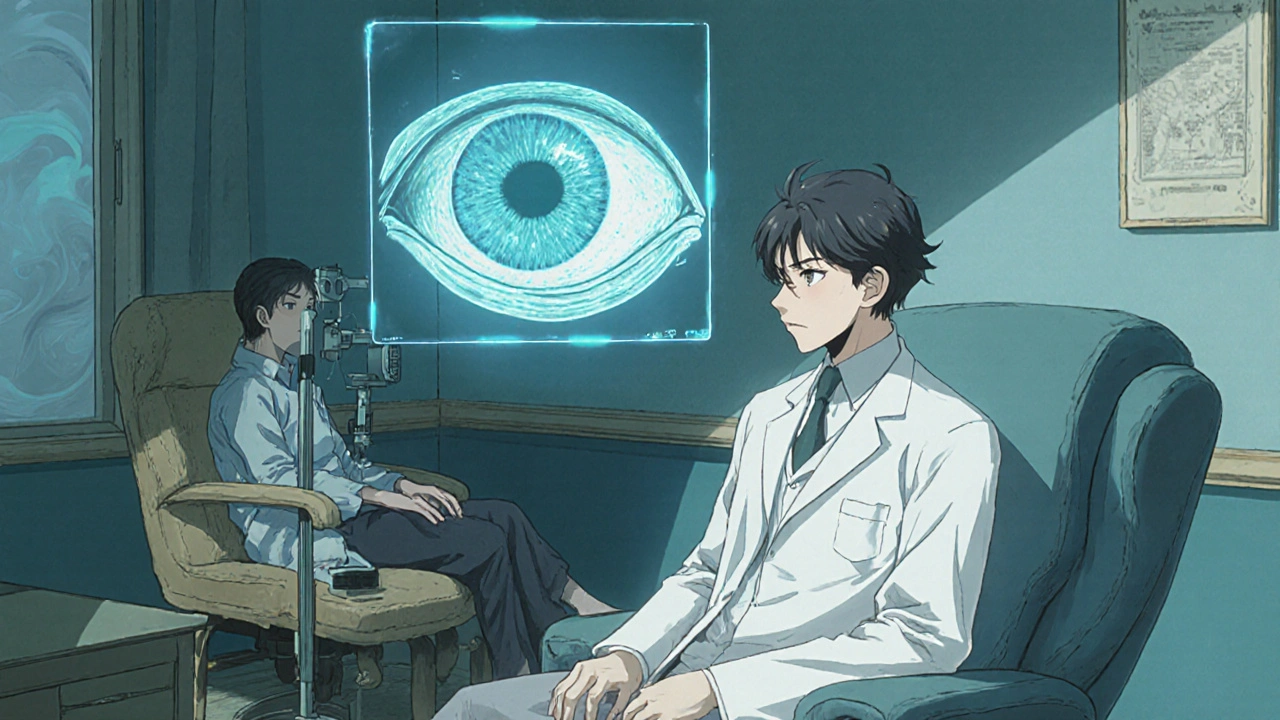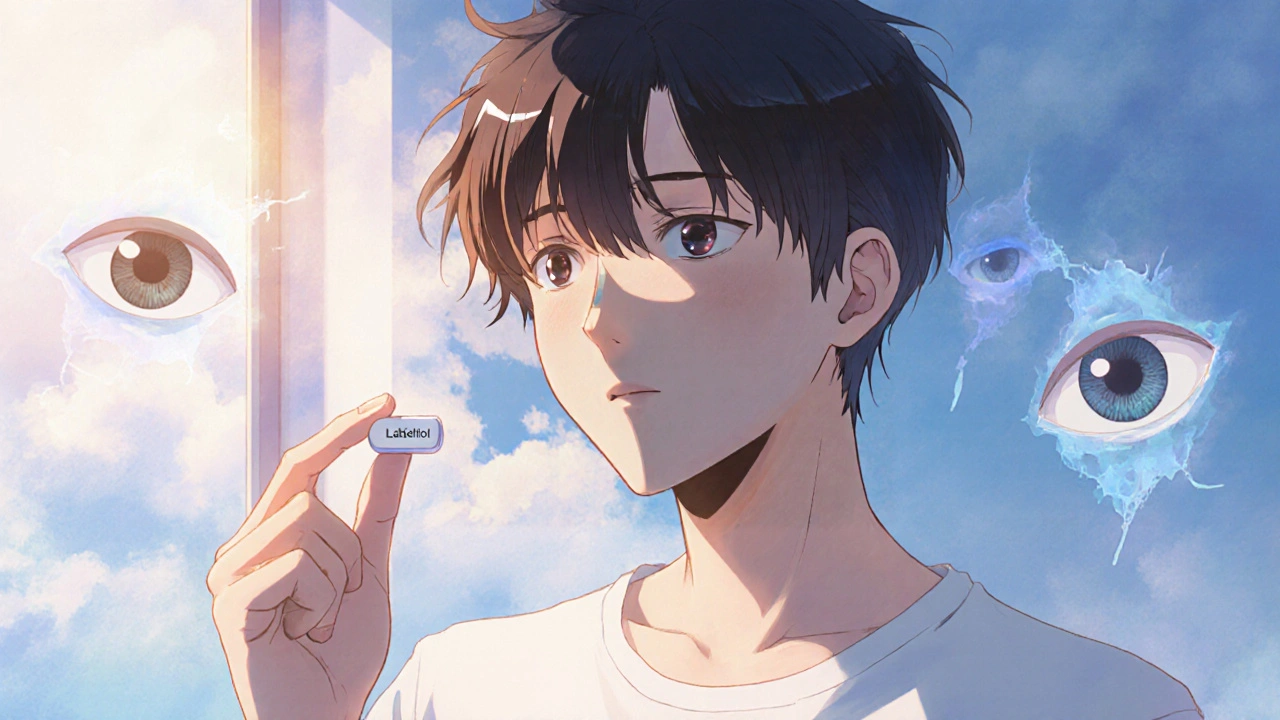When you first hear that a blood‑pressure pill might mess with your sight, you probably wonder if it’s a myth or a real risk. The short answer is: some people on Labetalol a mixed alpha‑ and beta‑adrenergic blocker used for hypertension and certain heart conditions do report vision changes, but the overall picture is nuanced. This guide walks through what the drug does, which eye symptoms have been tied to it, how doctors check for problems, and what you can do to stay ahead of any trouble.
What Is Labetalol and How Does It Work?
Vision the ability of the eyes to perceive light, color, and detail isn’t something you normally link to blood‑pressure meds, but understanding the drug’s mechanism helps explain why it can occasionally affect the eyes. Labetalol blocks both alpha‑1 and beta‑adrenergic receptors. Alpha‑1 blockade relaxes blood vessels, lowering resistance; beta‑blockade slows the heart and reduces cardiac output. The combined effect makes it effective for acute and chronic hypertension, especially in pregnancy or in patients who can’t tolerate pure beta‑blockers.
Because those receptors are also present in the eye’s vascular and muscular tissue, interfering with them can, in theory, change blood flow to the retina or alter the eye’s ability to focus. Most users never notice anything, but a small subset experiences side effects ranging from mild dryness to more serious retinal issues.
Common Side Effects of Labetalol (Beyond the Eyes)
- Fatigue and dizziness - often linked to the sudden drop in blood pressure.
- Cold hands and feet - a result of peripheral vasodilation.
- Headache - can be a sign of fluctuating blood pressure.
- Gastrointestinal upset - nausea or abdominal pain in some patients.
These are the symptoms you’ll read about in most patient information sheets. Ocular side effects sit lower on the list, but they’re worth a closer look because vision loss can be irreversible if not caught early.
Eye‑Related Side Effects Reported With Labetalol
Clinical trials and post‑marketing surveillance have identified a handful of eye‑specific reports. The most frequently mentioned issues include:
- Blurred vision - usually temporary and often coincides with the drug’s peak plasma level.
- Dry eye syndrome - reduced tear production that can cause irritation and a gritty feeling.
- Changes in intraocular pressure (IOP) - a mild rise or fall that could affect glaucoma patients.
- Retinal vasculitis or microvascular changes - rare but documented in case studies.
- Transient visual field defects - patchy blind spots that resolve after dosage adjustment.
It’s essential to note that large‑scale epidemiological data show these events in less than 1% of users, making them uncommon. However, for anyone already dealing with eye disease, even a low‑probability risk deserves attention.
Who Is Most Likely to Experience Vision Changes?
Three main factors increase the odds of noticing eye problems while on labetalol:
- Pre‑existing ocular conditions - glaucoma, diabetic retinopathy, or severe dry eye make the eyes more vulnerable to any additional stress.
- High dosage - doses above 400 mg per day have been linked to a higher incidence of blurred vision in several case series.
- Concurrent medications - other drugs that affect blood flow, such as diuretics or calcium‑channel blockers, can compound the effect.
If you fall into any of these categories, proactive monitoring becomes a key part of safe therapy.
How Doctors Evaluate Eye Health for Labetalol Users
When you tell your cardiologist or primary‑care doctor about eye symptoms, they’ll typically refer you to an ophthalmologist. The eye exam may include:
- Visual acuity test - standard eye chart to gauge sharpness.
- Intraocular pressure measurement - using a tonometer, especially important for glaucoma risk.
- Dilated fundus examination - allows the doctor to see retinal vessels and detect any vasculitis.
- Optical coherence tomography (OCT) - high‑resolution imaging of retinal layers, useful for spotting subtle swelling.
These tests provide a baseline. If symptoms appear after starting labetalol, repeat testing helps determine whether the drug is the culprit.

Managing and Reducing the Risk of Eye Problems
Here’s a practical checklist you can follow to keep your vision safe while treating hypertension:
- Report any visual change immediately - even fleeting blur or new floaters deserve a call to your doctor.
- Ask for a baseline eye exam before starting labetalol, especially if you have a history of eye disease.
- Schedule follow‑up eye checks every 6‑12 months while on the medication.
- If dry eye is an issue, consider over‑the‑counter lubricating drops and limit screen time.
- Discuss dosage adjustments if you notice persistent symptoms; sometimes a lower dose or split dosing helps.
- Ask about alternative antihypertensives (e.g., ACE inhibitors or calcium‑channel blockers) if eye side effects worsen.
Most patients find that simple steps-staying hydrated, using artificial tears, and keeping regular eye appointments-prevent any serious complications.
Comparing Ocular Side Effects Across Antihypertensive Classes
| Class | Example Drug(s) | Typical Eye‑related Effects |
|---|---|---|
| Beta‑blocker | Propranolol, Metoprolol | Dry eye, reduced tear secretion |
| Alpha‑blocker | Doxazosin, Prazosin | Blurred vision, orthostatic dizziness |
| Mixed alpha/beta (Labetalol) | Labetalol | Blurred vision, IOP changes, rare retinal vasculitis |
| ACE inhibitor | Lisinopril, Enalapril | Very low incidence; occasional conjunctival hyperemia |
| Calcium‑channel blocker | Amlodipine, Diltiazem | Peripheral edema can affect eyelids; occasional visual disturbances |
The table shows that while labetalol’s eye‑related profile isn’t unique, its mixed mechanism gives it a slightly broader symptom range compared with pure beta‑blockers.
What the FDA Says About Labetalol and Eye Safety
The U.S. Food and Drug Administration (FDA) tracks adverse events through the FAERS database. A search for “labetalol” and “vision” returns a handful of reports, most of which describe mild, reversible symptoms. No black‑box warning has been issued, but the label does list “visual disturbances” as a possible adverse reaction. This regulatory stance reinforces that eye side effects are uncommon but worth monitoring.
Bottom Line: Should You Stop Labetalol If You Notice Vision Problems?
Stopping the medication abruptly can cause a rebound rise in blood pressure, which itself can damage the eyes. The smarter move is to discuss any new visual symptoms with your healthcare provider. They may:
- Order an eye exam to rule out other causes.
- Adjust the dose or switch to a different antihypertensive class.
- Recommend supportive eye care (lubricating drops, protective eyewear).
In most cases, a simple dosage tweak resolves the issue without sacrificing blood‑pressure control.
Quick Checklist for Patients on Labetalol
- Know your baseline vision - get an eye exam before starting.
- Track any eye symptoms in a journal (date, description, severity).
- Report blurry vision, flashes, floaters, or dry eye promptly.
- Keep follow‑up appointments with both your cardiologist and ophthalmologist.
- Stay hydrated and use artificial tears if dryness persists.
This proactive approach helps you enjoy the blood‑pressure benefits of labetalol while keeping your sight safe.
Can labetalol cause permanent vision loss?
Permanent loss is extremely rare. Most reported cases involve temporary blurring or dry eye that improve after dose adjustment or treatment of the eye condition.
What eye tests are recommended after starting labetalol?
A standard visual acuity chart, intraocular pressure measurement, dilated fundus exam, and optionally optical coherence tomography (OCT) provide a thorough baseline.
Are there alternatives to labetalol that are gentler on the eyes?
ACE inhibitors (like lisinopril) and some calcium‑channel blockers have a lower incidence of ocular side effects, but the best choice depends on your overall health profile.
How quickly do eye symptoms appear after taking labetalol?
Symptoms can start within hours of the first dose, especially at higher doses, but many patients never notice any change.
Should I use over‑the‑counter eye drops while on labetalol?
Lubricating drops are safe and can relieve dryness. Avoid drops with preservatives if you need to use them frequently; consult your eye doctor for recommendations.


the sagar
October 24, 2025 AT 20:48Labetalol is just another tool of the pharma cartel to keep us dependent.
Shannon Stoneburgh
October 31, 2025 AT 07:42The guide lists side effects, but the real issue is how patients often ignore subtle eye changes until damage is done. Many dismiss dry eye as trivial, yet chronic irritation can signal deeper vascular problems. A baseline exam can catch these issues early.
Nathan Comstock
November 6, 2025 AT 18:37People need to understand that the drug’s dual action isn’t just a harmless convenience. It interferes with ocular receptors, and that can shift retinal blood flow. In my experience, high doses have caused noticeable blurring within days. Ignoring these signs is reckless, especially when alternatives exist. Your vision deserves better than a guesswork approach.
Corrine Johnson
November 13, 2025 AT 05:31Consider the philosophical implications of pharmacology, my dear readers; the eye, a window to the soul, is being manipulated by chemical agents, and yet we accept it without protest. Is it not a betrayal of our natural perception? The literature mentions microvascular changes, but the deeper meaning lies hidden beneath statistical tables. One must question the ethics of prescribing a drug that can cloud the very lens through which we view the world.
Jennifer Stubbs
November 19, 2025 AT 16:26Your point about ethics is valid, but we should also look at the data trends. Controlled studies show less than 1% incidence of serious ocular events. That statistic suggests the risk is manageable with proper monitoring. Over‑analysis can lead to unnecessary alarm. Still, vigilance remains essential.
Abby W
November 26, 2025 AT 03:20Hey, I totally get the concern 🙌. If you feel any weird dryness or blur, just grab some lubricating drops 😎. It’s cheap and easy, so why suffer?
Clinton Papenfus
December 2, 2025 AT 14:15Patients prescribed labetalol should first obtain a comprehensive ophthalmic baseline. This includes visual acuity, intraocular pressure measurement, and a dilated fundus examination. The clinician should document retinal vessel appearance using OCT whenever possible. Follow‑up examinations are recommended at six‑month intervals for the first year. Any new visual complaint warrants immediate reassessment. Dosage adjustments may alleviate transient blurring. In cases of pre‑existing glaucoma, close monitoring of intraocular pressure is crucial. Collaboration between cardiology and ophthalmology enhances patient safety. Education about symptom recognition empowers patients. Hydration and regular use of preservative‑free artificial tears can mitigate dryness. Lifestyle modifications, such as reduced screen time, support ocular health. If retinal vasculitis is suspected, prompt referral for angiographic studies is advised. Alternate antihypertensive agents may be considered when ocular side effects persist. The decision to switch therapy must balance blood pressure control and visual risk. Ultimately, proactive surveillance prevents irreversible damage.
Zaria Williams
December 9, 2025 AT 01:09i read that labetalol can cause some weird vision stuff, like blurrin and dry eye. it's not common but still kinda scary if you got oca or diyabetes. also, high dose might make it worse. so keep an eye on it lol.